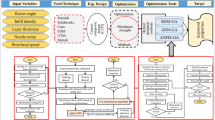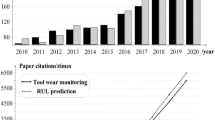Abstract
This paper presents a partitioning around medoid (PAM)-based novel method to realize the recognition of the tool wear state in milling. In PAM, the representative objects called medoids are used to define clusters and average dissimilarities are applied to assess the medoids, which make PAM robust to outliers and therefore improve the clustering performance. Meanwhile, locality preserving projections (LPP) method is utilized to further increase the clustering accuracy by dimension reduction. To show the effectiveness of the proposed method, end milling experiment of Ti-6Al-4V alloy were carried out and the commonly used k-means and fuzzy c-means (FCM) algorithm are introduced to make a comparison with PAM algorithm by using five clustering evaluation indicators. The results show that PAM performs higher accuracy and robustness than the other two clustering algorithm.
Similar content being viewed by others
References
Li XL (2002) A brief review: acoustic emission method for tool wear monitoring during turning. Int J Mach Tool Manuf 42(2):157–165
Siddhpura A, Paurobally R (2013) A review of flank wear prediction methods for tool condition monitoring in a turning process. Int J Adv Manuf Technol 65:371–393
Sick B (2002) On-line and indirect tool wear monitoring in turning with artificial neural networks: a review of more than a decade of research. Mech Syst Signal Process 16(4):487–546
Dimla E Dimla Snr (2000) Sensor signals for tool-wear monitoring in metal cutting operations—a review of methods. Int J Mach Tool Manuf 40(8):1073–1098
Rehorn AG, Jiang J, Orban PE (2005) State-of-the-art methods and results in tool condition monitoring: a review. Int J Adv Manuf Tech 26(7):693–710
Zhu KP, Wong YS, Hong GS (2009) Wavelet analysis of sensor signals for tool condition monitoring: a review and some new results. Int J Mach Tool Manuf 49(7–8):537–553
Gaja H, Liou F (2016) Automatic detection of depth of cut during end milling operation using acoustic emission sensor. Int J Adv Manuf Technol. doi:10.1007/s00170-016-8395-9
Godfrey CO, Petr B, Frank L (2008) Modeling tool wear in end-milling using enhanced GMDH learning networks. Int J Adv Manuf Technol 39:1080–1092
García-Nieto PJ, García-Gonzalo E, Vilán Vilán JA, Segade Robleda A (2015) A new predictive model based on the PSO-optimized support vector machine approach for predicting the milling tool wear from milling runs experimental data. Int J Adv Manuf Technol. doi:10.1007/s00170-015-8148-1
Cho S, Binsaeid S, Asfour S (2010) Design of multisensor fusion-based tool condition monitoring system in end milling. Int J Adv Manuf Technol 46:681–694
Wang GF, Liu C, Cui YH (2012) Clustering diagnosis of rolling element bearing fault based on integrated autoregressive/autoregressive conditional heteroscedasticity model. J Sound Vib 331:4379–4387
Hu D, Sarosh A, Dong YF (2012) A novel KFCM based fault diagnosis method for unknown faults in satellite reaction wheels. ISA Trans 51:309–316
Yuwono M, Qin Y, Zhou J, Guo Y, Celler BG, Su SW (2015) Automatic bearing fault diagnosis using particle swarm clustering and Hidden Markov Model. Eng Appl Artif Intell. doi:10.1016/j.engappai.2015.03.007
Baraldi P, Maio FD, Rigamonti M, Zio E, Seraoui R (2015) Clustering for unsupervised fault diagnosis in nuclear turbine shut-down transients. Mech Syst Signal Process 58–59:160–178
Wang G, Yin S (2014) Data-driven fault diagnosis for an automobile suspension system by using a clustering based method. J Franklin Inst 351:3231–3244
Liu WY, Wang ZF, Han JG, Wang GF (2013) Wind turbine fault diagnosis method based on diagonal spectrum and clustering binary tree SVM. Renew Energy 50:1–6
Zhou JH, Pang CK, Zhong ZW, Lewis FL (2011) Tool wear monitoring using acoustic emissions by dominant-feature identification. IEEE Trans Instrum Meas 60(2):547–559
Jipkate BR, Gohokar VV (2012) A comparative analysis of fuzzy C-means clustering and K means clustering algorithms. IJCER 2(3):737–739
Li XL, Yuan ZJ (1998) Tool wear monitoring with wavelet packet transform-fuzzy clustering method. Wear 219(2):145–154
Fu P, Yi WL, Guo L (2011) Fuzzy clustering and visualization analysis of tool wear status recognition. PEEA 23:479–486
Li WL, Fu P, Zhang EQ (2013) Application of fractal dimensions and fuzzy clustering to tool wear monitoring. TELKOMNIKA 11(1):187–194
Simeone A, Woolley EB, Rahimifard S (2015) Tool state assessment for reduction of life cycle environmental impacts of aluminium machining processes via infrared temperature monitoring. Procedia CIRP 29:526–531
Kaufman L, Rousseeuw PJ (1990) Finding groups in data: an introduction to cluster analysis. Wiley-Interscience, America
Bhattacharyya P, Sengupta D, Mukhopadhyay S (2007) Cutting force-based real-time estimation of tool wear in face milling using a combination of signal processing techniques. Mech Syst Signal Process 21:2665–2683
Aknouche H, Outahyon A, Nouveau C, Marchal R, Zerizer A, Butaud JC (2009) Tool wear effect on cutting forces: in routing process of Aleppo pine wood. J Mater Process Technol 209:2918–2922
Rizala M, Ghania JA, Nuawia M, Che Haron CH (2013) The application of I-kazTM-based method for tool wear monitoring using cutting force signal. MITC2013 68:461–468
Abu-Mahfouz I, Banerjee A (2014) Drill wear feature identification under varying cutting conditions using vibration and cutting force signals and data mining techniques. Procedia Comput Sci 36:556–563
He XF, Niyogi P (2003) Locality preserving projections. In: Thrun S, Saul LK, Schölkopf B (ed) Advances in Neural Information Processing Systems 16 (NIPS 2003). Vancouver
Song MJ, Zhang L (2008) Comparison of cluster representations from partial second—to full fourth-order cross moments for data stream clustering, data mining. 2008 ICDM ‘08 143:560–569
Strehl A, Ghosh J (2002) Cluster ensembles—a knowledge reuse framework for combining multiple partitions. J Mach Learn Res 3:583–617
Wu M, Schölkopf B, (2007) A local learning approach for clustering. In: Schölkopf B, Platt J, Hofmann T (ed) Advances in Neural Information Processing Systems 19 (NIPS 2006). Vancouver
Aghabozorgi S, Shirkhorshidi AS, Wah TY (2015) Time-series clustering—a decade review. Inf Syst 53:16–38
Liao TW (2005) Clustering of time series data—a survey. Pattern Recogn 38:1857–1874
Author information
Authors and Affiliations
Corresponding author
Rights and permissions
About this article
Cite this article
Li, Z., Wang, G. & He, G. Milling tool wear state recognition based on partitioning around medoids (PAM) clustering. Int J Adv Manuf Technol 88, 1203–1213 (2017). https://doi.org/10.1007/s00170-016-8848-1
Received:
Accepted:
Published:
Issue Date:
DOI: https://doi.org/10.1007/s00170-016-8848-1




